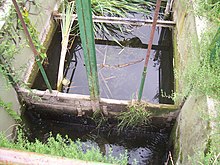Malchower See (Berlin)
| Malchower See | ||
|---|---|---|

|
||
| The lake as seen from the ditch. | ||
| Geographical location | Central Europe , Germany , Berlin | |
| Tributaries | Hechtgraben, Fenngraben | |
| Drain | River ditch | |
| Data | ||
| Coordinates | 52 ° 34 ′ 27 " N , 13 ° 29 ′ 18" E | |
|
|
||
| surface | 7.4 ha | |
| volume | 226,555 m³ | |
| Maximum depth | 6.46 m | |
| Middle deep | 3.05 m | |
The Malchower See is located on the northeastern outskirts of Berlin in the Lichtenberg district and borders the Malchow district to the east and the Malchower Aue to the south .
General
The water surface of the Malchower See has a size of 74,318 m², the entire water body has a volume of 226,555 m³ and the average depth is 3.05 m, the greatest depth of the lake being 6.46 m. The total circumference of the shoreline of the Malchower See is 1,228 m. The Malchower See is fed by rainwater from the Malchower Aue over the Malchower Dorfgraben. The water is drained through the Malchower river ditch in the southwest of the lake into the Panke .
The Hechtgraben feeds water to the lake from the east. The ditch separates the Lichtenberg districts of Malchow and Neu-Hohenschönhausen.
The area around the Malchower See shows a strong landscape structure, which is often due to the influence of humans. There is a landscaped park with lawns in the southeast, which is used by the population as a local recreation area. In the southern area there is a smaller wooded area with ash, maple and poplar vegetation. The western area of the lake has a heavy vegetation with reed beds , which is followed by a meadow used as a pasture for cattle. In the north of the lake you can find the quarry forest zone with a large number of dead trees. The eastern shore of the lake is also covered with a narrow belt of reed beds.
The Malchower See is a fishing water, but not a swimming lake. Bathing has been banned so that the green and recreational area as well as the reed belt, which provides nesting opportunities for rare water birds, are not endangered.
Origin and history
The formation of the Malchower See took place in the Vistula Ice Age about 25,000 to 16,000 years ago. The furthest advance of the glaciers with the maximum ice edge position about 50 km south of Berlin, which is known as the Brandenburg Stadium, changed the surface morphology of the Barnimplatte . This means that material has been partially deposited and partially eroded . This created a depression in the young moraine, which was filled with ice. When the ice retreated, a block of dead ice remained in the depression , which formed the body of water after thawing.
From the 19th to the middle of the 20th century, the areas around Malchower See were used as sewage fields for Berlin's sewage. In 1953, when the LPG Wartenberg was founded, wastewater was discharged. For this reason, the digested sludge layer at the bottom of the lake was removed at the end of the 1980s with the help of a floating dredger. The Hechtgraben was later given a new bed to prevent further pollution. However, this had the consequence that the water level sank, which is why a weir was built at the river ditch to hold the water.
Livestock
The wetland at Malchower See is an important habitat for amphibians (toads, frogs), which can be found particularly in the northern area due to the restricted access for humans. There are also numerous water birds such as mallards, swans, great crested grebes and pond racks that live and breed in the area of Lake Malchower. The reed stocks serve primarily as the breeding space. The lake is also a habitat for species of fish such as perch, carp, pike, pikeperch, catfish, eel and tench.
Since around winter 2005/2006, two Nutrias have settled at Malchower See , which were able to reproduce successfully, especially by feeding the residents. For a few years now, a red-eared slider turtle has been living at Lake Malchower , which is believed to have been privately owned and released.
literature
- K. Zintz, C. Steinberg, G. Waiditschka: Natural paradise lake. Shapes, history, animals and plants , Naturbuch Verlag, Augsburg 1993, ISBN 3-89440-030-7 .
Assessment
- Ilona Beuchel, Sabine Möbius: Determination of the condition of the shore areas of the Malchower See . Project work, 1991
- Stephan Karl: Water analyzes of the Malchower See in the course of the year , 2006
Web links
Individual evidence
- ↑ Berlin Water Atlas Part 5.2 (PDF; 1.2 MB)
- ↑ Distance from the groundwater level in 2009: Malchower See and Hechtgraben
- ↑ Bathing in the Malchower See is not allowed . In: Berliner Zeitung , July 31, 1995


